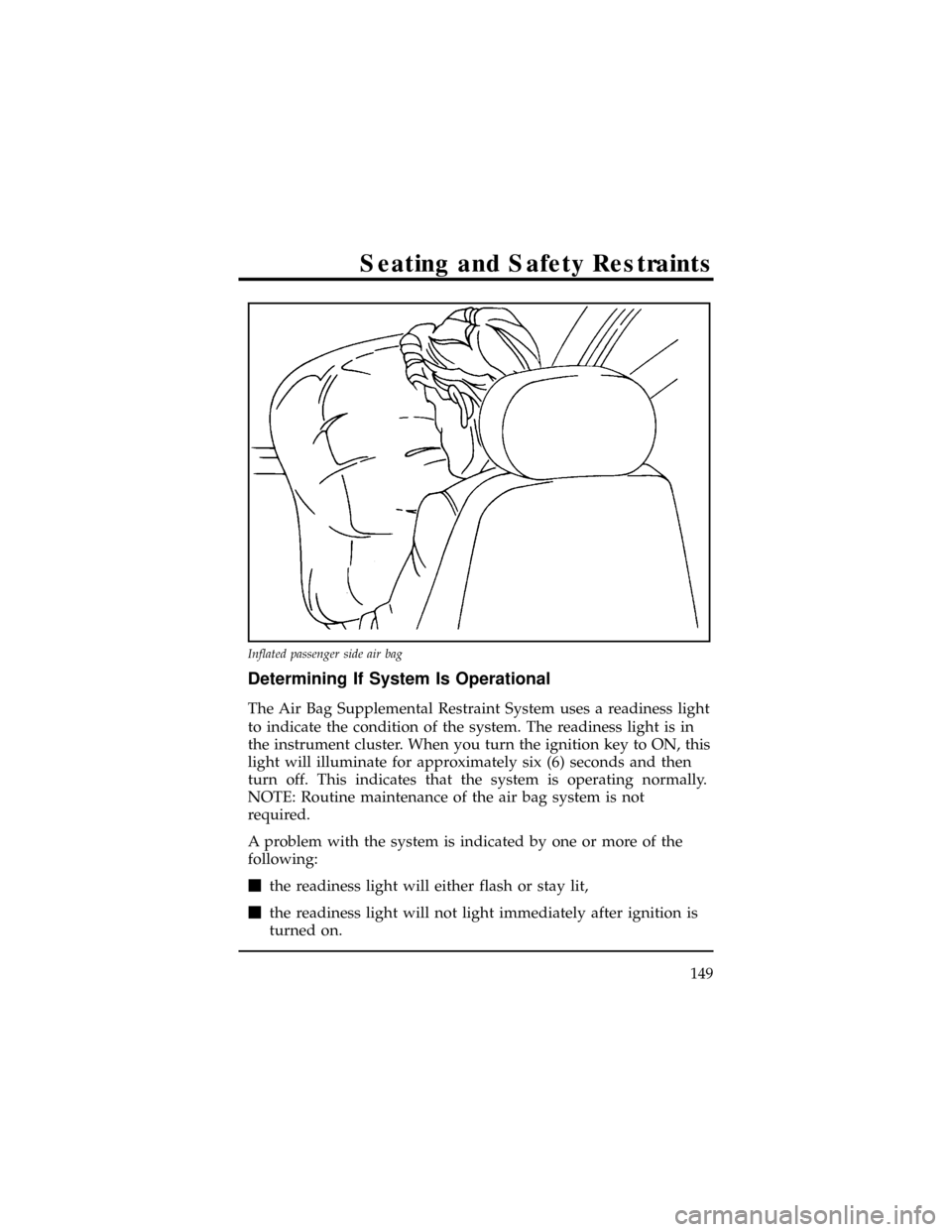Mercury Villager 1998 Owner's Manuals
Manufacturer: MERCURY, Model Year: 1998, Model line: Villager, Model: Mercury Villager 1998Pages: 400, PDF Size: 2.06 MB
Page 151 of 400

WARNING
Several air bag system components get hot after inflation.
Do not touch them after inflation.
WARNING
The air bag will inflate only once. The system is designed
to function on a one-time-only basis. If the air bag is
inflated, THE AIR BAG WILL NOT FUNCTION AGAIN
AND MUST BE REPLACED IMMEDIATELY. If the air
bag is not replaced, this will increase the risk of injury in
a subsequent collision.
The location of air bags and warning labels
Seating and Safety Restraints
147
Page 152 of 400

The Air Bag Supplemental Restraint System consists of:
mdriver and passenger air bag modules (which include the
inflators and air bags),
mone or more impact and safing sensors,
ma system diagnostic module,
ma readiness light,
mand the electrical wiring which connects the components.
The diagnostic module monitors its own circuits, the air bag
electrical system, the air bag readiness light, the air bag power and
the air bag inflators.
Inflated driver side air bag
148
Page 153 of 400

Determining If System Is Operational
The Air Bag Supplemental Restraint System uses a readiness light
to indicate the condition of the system. The readiness light is in
the instrument cluster. When you turn the ignition key to ON, this
light will illuminate for approximately six (6) seconds and then
turn off. This indicates that the system is operating normally.
NOTE: Routine maintenance of the air bag system is not
required.
A problem with the system is indicated by one or more of the
following:
mthe readiness light will either flash or stay lit,
mthe readiness light will not light immediately after ignition is
turned on.
Inflated passenger side air bag
Seating and Safety Restraints
149
Page 154 of 400

If any of these things happen, even intermittently, have the Air
Bag Supplemental Restraint System serviced at your Ford or
Lincoln-Mercury dealer immediately. Unless serviced, the
system may not function properly in the event of a collision.
Disposal of Air Bags and Air Bag Equipped Vehicles
For disposal of air bags or air bag equipped vehicles, see your local
Ford or Lincoln-Mercury dealer. Air bags MUST BE disposed
of by qualified personnel.
150
Page 155 of 400

Safety Restraints for Children
In the U.S. and Canada, you are required by law to use safety
restraints for children. If small children ride in your vehicle Ð this
generally includes children who are four years old or younger
and who weigh 40 pounds (18 kg) or less Ð you must put them
in safety seats that are made specially for children. Safety
belts alone do not provide maximum protection for these children.
Check your local and state laws for specific requirements.
WARNING
Never let a passenger hold a child on his or her lap while
the vehicle is moving. The passenger cannot protect the
child from injury in a collision.
WARNING
To prevent the risk of injury, make sure children sit where
they can be properly restrained.
WARNING
It is extremely dangerous to ride in a cargo area, inside or
outside of a vehicle. In a collision, people riding in
these areas are more likely to be seriously injured or killed.
Do not allow people to ride in any area of your vehicle
that is not equipped with seats and safety belts. Be sure
everyone in your vehicle is in a seat and using a safety
belt properly.
Seating and Safety Restraints
151
Page 156 of 400

WARNING
Whenever possible, put children in one of the rear seats
in your vehicle. Accident statistics indicate that children are
safer when properly restrained in the rear seats than in
the front seats.
WARNING
Carefully follow all of the manufacturer's instructions
included with the safety seat you put in your vehicle. If you
do not install and use the safety seat properly, the child
may be injured in a sudden stop or collision.
WARNING
Safety belts and seats can become hot in a vehicle that has
been closed up in sunny weather; they could burn a
small child. Check seat covers and buckles before you place
a child anywhere near them.
WARNING
Do not leave children, unreliable adults, or pets
unattended in your vehicle.
152
Page 157 of 400

Safety Seats for Children
Use a safety seat that is recommended for the size and weight of
the child. Always follow the safety seat manufacturer's
instructions when installing and using the safety seat.
Ford recommends the use of a child safety seat having a top
tether strap. Install the child safety seat in a seating position which
is capable of providing a tether anchorage. For more
information on top tether straps seeAttaching Safety Seats With
Tether Strapsin this chapter.
When installing a child safety seat, be sure to use the correct
safety belt buckle for that seating position, make sure the tongue
is securely fastened in the buckle and there is tension in the
belt. For a shoulder/lap belt combination with a sliding tongue,
make sure the retractor is in the automatic locking mode. For
more information, seeUsing the Automatic Locking Mode Retractor
to Secure a Child Safety Seatlater in this chapter.
All child restraint systems are designed to be secured in vehicle
seats by lap belts or by the lap portion of a lap-shoulder belt.
Seating and Safety Restraints
153
Page 158 of 400

WARNING
Rear-facing child seats or infant carriers should never be
placed in the front seats.
WARNING
If you do not properly secure the safety seat, the child
occupying the seat may be injured during a collision or
sudden stop. An unsecured safety seat could also injure
other passengers.
The passenger side quick-release second row captain seat is
adjustable along a track and may be adjusted very close to the
front passenger seat to allow easier entry and exit to third row seats.
WARNING
The quick-release seat must be adjusted to the rearmost
position when using an untethered forward-facing child
safety seat.
WARNING
The third row seat must be adjusted to the rearmost
position when using an untethered forward facing child
safety seat.
154
Page 159 of 400

WARNING
Always keep the buckle release button pointing upward
and away from the child seat, with the tongue between the
child seat and the release button as shown in the
following illustration.
WARNING
Failure to follow all instructions on the proper use of
child seats or the vehicle restraint systems can result in
serious injury or death in the event of a sudden stop or
collision.
Safety belt buckle placement for child seats
Seating and Safety Restraints
155
Page 160 of 400

Using the Automatic Locking Mode Retractor to Secure
a Child Safety Seat
Your vehicle is equipped with a dual locking mode retractor on
the shoulder belt portion of the combination lap/shoulder safety
belt for the front passenger seat and rear outer seats. The
automatic locking modemust be usedwhen installing a child
seat or infant carrier in the front passenger seat or rear outer seats.
To install a child safety seat or infant carrier, follow these steps:
1. Position the child seat or infant carrier in the vehicle seat. If you
are using the moveable third row seat in the third row
position, the passenger side second row bucket seat, or the
front passenger seat, slide the seat to the rearmost position.
2. Follow the child seat or infant carrier manufacturer's
instructions. Route the safety belt through the child seat or
infant carrier and insert the safety belt tongue into the buckle
until you hear and feel the latch engage. Be sure to follow
the child safety seat manufacturer's instructions for belt
routing. When using the seating position near the sliding door
on the two-passenger bench seat, be sure that the single
window tongue is attached to the auxillary buckle on the side
of the seat.
156